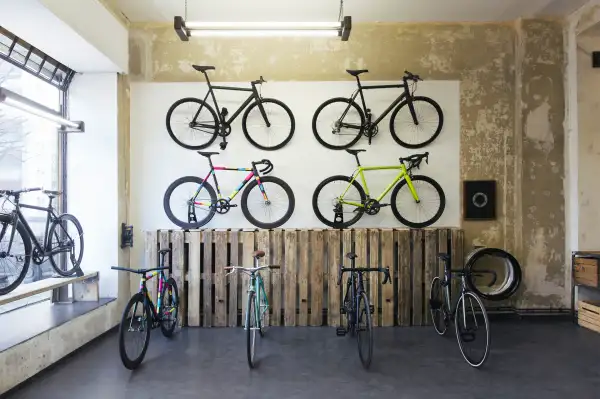How to Buy a Bike in the Middle of the Largest Shortage in US History

The United States is facing its first bicycle shortage in nearly half a century.
The last time Americans were in such a frenzy to get their hands on a pair of handlebars was in the early 1970s, on the heels of the first major environmentalist movement. Now, in the middle of a pandemic that spreads in close quarters, commuters in cities that rely heavily on public transportation like San Francisco and New York have been flocking to bike shops and big-box stores, and often coming out with nothing — sometimes for months on end.
According to data from CitiBike, the privately-owned bike-sharing system serving New York City, ridership has nearly doubled between March and June 2020 as stir-crazy apartment-dwellers jumped on any opportunity to safely leave their cramped quarters, even if they can’t find a permanent bike of their own.
This trend hasn’t been isolated to big cities. Cooped-up suburban residents and others living in historically car-dependent areas are desperate to get themselves—and in some cases, their kids—out of the house and into some fresh air, says Alex Strickland, a representative for the Adventure Cycling Association, a Missoula, MT-based non-profit.
“They’re looking for something exciting they can do from their front door,” he says.
Unfortunately, he adds, it’s never been more difficult to buy a bike.
Why is it so hard to buy a bike right now?
When China and Taiwan — the two countries that supply nearly all of American bicycle brands with parts — shut down nearly all businesses during the coronavirus outbreak in January and February, production of some of the largest bicycle manufacturing companies including Giant Bicycles and Fuji-ta came to a grinding halt, which in turn zapped the supply chain for retailers in the states during the months of March and April, just as the pandemic was kicking off and motivating people to find new modes of transportation.
According to the U.S. Department of Commerce, demand in May 2020 was up 61% — far outpacing supply.
Although imports are picking back up as the country heads into the second half of the summer, retailers big and small are still making up for those earlier delays, with most new imports going directly to those on the waitlist.
“It’s already not a supply chain that can react very quickly,” says Strickland. “Nobody saw this huge spike in demand coming until it was already too late.”
For boutique manufacturers who serve a more niche customer-base of experienced and passionate riders, demand has become particularly overwhelming. Doug Learmont, an avid cyclist from El Paso, TX says he was surprised when, after inquiring about how long his new bike would take to get to him, a representative from a boutique titanium bike company told him that their inventory system was managed entirely by excel sheets instead of any sort of management software.
“I think a big concern for these small manufacturers is that they don’t have the technology or workforce to keep their workflow organized,” says Learmont.
Learmont says he ultimately received the bike 7 weeks after purchasing it. His previous bike, purchased in February, took just four days to ship from California to Texas.
The bicycle industry’s woes don’t stop there: Exclusions to tariffs on Chinese imports have allowed American companies to easily purchase materials necessary for bike manufacturing since 2018. But those are set to expire by the end of September, which means a 25% tariff will soon be imposed on the parts necessary to repair and build most bicycles sold in U.S. stores.
Where to look — and what to look for
It’s not completely impossible to find a good bike these days, but it does require some creative maneuvering.
Your best bet right now, most likely, is to buy second hand.
“Don’t get caught up in the idea that you need a new or fancy bike in order to be a cyclist,” says Strickland.
Most local shops are already flooded with customers, so you’ll probably have better luck with individual sellers on Facebook Marketplace or Craigslist.
Unlike most cars, a bike can basically run forever with very few “updates” besides the occasional tune-up and tire replacement. If you find a 30-year-old bike on Craigslist that looks like it's in great shape, you can rest easy knowing it will probably last a long time so long as it’s been taken care of.
To figure out the approximate size you need, measure your inseam. For each length range, there is a corresponding bike frame size and descriptive size.
If you can’t see the bike in-person to inspect it for wear and tear, ask the seller to send over a short video “tour” of the bike’s features so you can look for dents and scratches. You should also read up about the model of bike you’re interested in online. Check out what it’s designed for (road biking? mountain biking?), how much new models sell for, and its resale value.
“Spending a few hours doing research can save you a ton of money,” says Robin Graven-Milne, co-owner of Haven Cycles in Brooklyn, NY.
When in doubt, reach out to your local bike shop with any concerns you may have about a bike you’re interested in purchasing, even if you’re not buying it from them.
“At the end of the day, we just want people to ride bikes,” Graven-Milne says.
Consider springing for some new tires
Depending on the type of biking you’re looking to do, you might want to opt for a different set of tires than the ones your bike came with.
If you’re a city-dweller living in a fourth-floor walk-up, it’s probably beneficial to stick with thin, lightweight tires that are easy to lug up and down the stairs. But if you plan on getting your adventure on, fatter tires can keep you cushioned and supported after hours of riding. They can set you back about $100 per tire, but the investment might be worth it if you're worried about comfort — plus, they’ll last a lot longer than thinner tires.
It's worth knowing that a vintage bike that’s been well cared for can be a great option for many riders, but tire sizes for bikes in the U.S. weren't standardized until the 1990s. During the 1970s and ‘80s, the standard size for some American road bike tires was 27 inches, while most of today’s bikes use the standard 26 inch version. Some shops carry the 27-inch model, but you might need to find a specialty shop, or order them online, depending on where you’re located.
You bought a new bike. Now what?
For some, a bike is a simple vehicle for putzing around the neighborhood on sunny afternoons. For others, biking is a way of life. Either way, the more people make the switch to cycling right now, the more positive impact it will have on the biking community as a whole.
“Will some of these bikes end up collecting dust in the back of a garage? Sure. But this moment has such amazing implications for city planners,” says Strickland.
Cities like Seattle have already turned heavily-trafficked streets into permanent pathways for bikers and pedestrians. The hope is that more car-dependent sprawling cities will eventually follow suit.
But even with changes that make choosing a bike over a car a more reasonable option, the idea of using it as your main mode of transportation can be daunting. Consider joining a local cyclist group online or in person if you’re feeling timid about hitting the road. Veteran cyclists are an incredible resource for learning the rules of the road and the ins and outs of bike maintenance. If you find someone who lives nearby, they'll probably be happy to go on a ride with you.
If you’re being safe (i.e. wearing a helmet!), and have done your research, you should be ready to get in the saddle.
“The biggest thing is starting out where you feel comfortable and just finding ways to make it fun,” says Graven-Milne.
More from Money:
Need Cash Fast? Payday Loans Offer a Solution but Should Be Your Last Resort
Can Your Birthday Really Determine Your Future Success? New Research Says Yes
